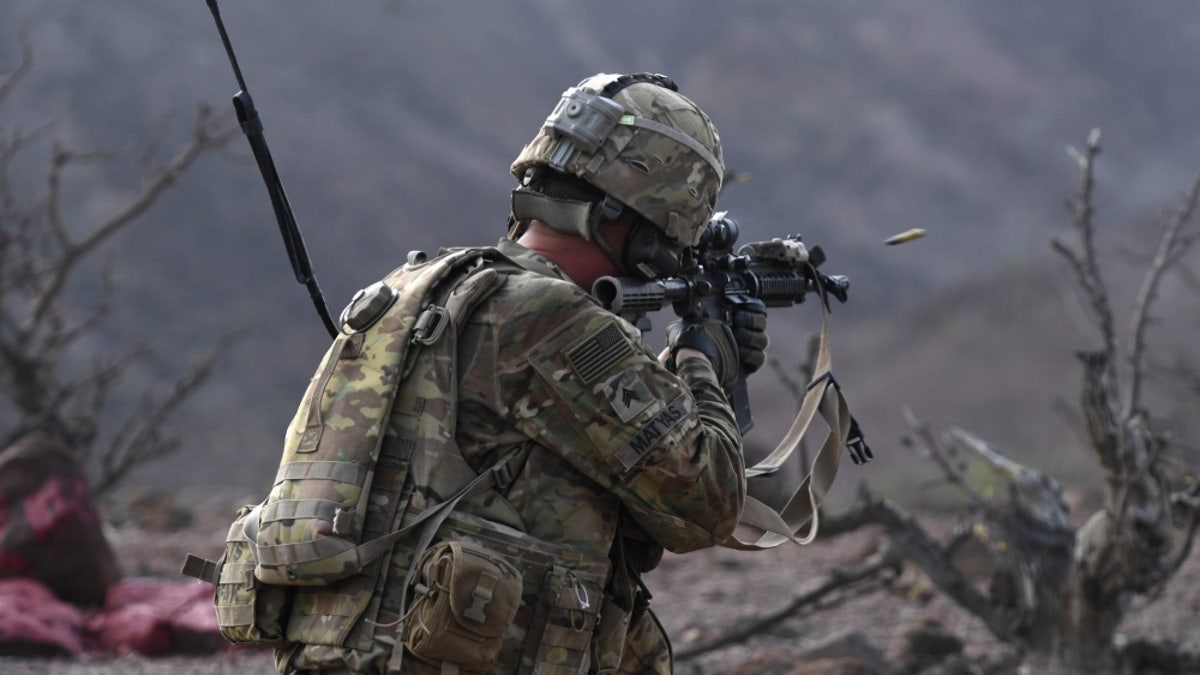
File photo - A 10th Mountain Division Soldier fires an M4 rifle during a platoon Situational Training Exercise at a range in Arta, Djibouti, Aug. 25, 2018. (U.S. Air Force photo by Senior Airman Haley D. Phillips)
Targets emerge in seconds, incoming enemy fire puts lives at risk and shifting combat dynamics require immediate, on-the-spot decisions in a matter of seconds -- all as soldiers navigate the complex web of threats during all-out, high-risk ground-warfare.
These kinds of predicaments, which characterize much of what soldiers train to face, are immeasurably improved by emerging applications of AI; artificial intelligence can already gather, fuse, organize and analyze otherwise disparate pools of combat-sensitive data for individual soldiers. Target information from night vision sensors, weapons sights, navigational devices and enemy fire detection systems can increasingly be gathered and organized for individual human soldier decision-makers.
However, what comes after this? Where will AI go next in terms of changing modern warfare for Army infantry on the move in war? The Army Research Laboratory is now immersed in a complex new series of research and experimentation initiatives to explore a “next-level” of AI. Fundamentally, this means not only using advanced algorithms to ease the cognitive burden for individual soldiers -- but also network and integrate otherwise stovepiped applications of AI systems. In effect, this could be described as performing AI-enabled analytics on groups of AI systems themselves.
“Autonomy is doing things in a snipped way that can be connected. We can benefit from an overarching AI approach, something that looks at the entire mission. Right now our autonomy solves very discreet problems that are getting more complicated,” J. Corde Lane, Ph.D., director, Human Research and Engineering, CCDC-Army Research Laboratory, told Warrior in an interview.
What does this mean? In essence, it translates into a way combat commanders will not only receive AI-generated input from individual soldiers but also be able to assess how different AI systems can themselves be compared to one another and analyzed as a dynamic group. For instance, Lane explained, perhaps multiple soldier-centric AI-empowered assessments can be collected and analyzed in relation to one another with a mind to how they impact a broader, squad-level combat dynamic. In particular, simultaneous analysis of multiple soldier-oriented AI system can help determine the best course of action for an entire unit, in relation to an overall mission objective.
“What is the entire mission and possible courses of action? Do we optimize the logistics flow? Find targets as the dynamic battlefield gets more complex? The Commander can draw upon advanced AI to explore new options,” Lane explained.
Therefore, in addition to drawing upon algorithms able to organize data within a given individual system, future AI will encompass using real-time analytics to assess multiple systems simultaneously and how they impact one another to offer an overall integrated view. All of this progress, just as is the case now, will still rely heavily upon human decision-making faculties to optimize its added value for combat. Integrating a collective picture, drawing upon a greater range of variables will require soldiers to incorporate new tactics and methods of analysis to best leverage the additional available information.
SOLDIERS USE AI TO FIRE PRECISION GRENADES, GUIDE DRONE ATTACKS
“When we have new and improved autonomy coming in, soldiers need to know how to use that. How do you keep the soldier always at the center and adapt to them as you adapt to the new AI?” Lane asked.
Perhaps one soldier receives organized sensor-driven targeting data relevant to a specific swath of terrain, while another AI system is organizing variables to determine the supply flow of ammunition, fuel or other logistical factors.
“Data never seen cannot be learned. It is not about AI, but combining AI with a soldier who has the concept of an entire mission. AI provides information and then they get put together. When you are under fire, you are going to need different types of information,” Lane explained.
For example, comparing and analyzing various AI systems to help engender a collective picture of some kind might enable a commander to know “if you go this way you will use more fuel but it will be safer,” as Lane explained.
HOW AI CHANGES ATTACK MISSIONS FOR US FIGHTER JETS AND BOMBERS
Interestingly, Lane’s point about the irreplaceable characteristics of human cognition in the face of new AI-driven technologies is anticipated in a 2017 essay from the Chatham House Royal Institute of International Affairs, called “Artificial Intelligence and the Future of War.” The essay, written by M.L. Cummings, states that “replicating the intangible concept of intuition, knowledge-based reasoning and true expertise is, for now, beyond the realm of computers.”
Mathematically oriented computer algorithms naturally face limitations when it comes to things like judgments, feelings or quickly assessing not-yet-seen information; an AI-database can only be as effective as the information it already has stored in its database. While Machine-Learning techniques continue to accelerate the pace at which an existing AI database can quickly integrate and perform analytics on new information, AI-infused computing can only make decisions or solve problems in relation to the information it already has stored. Now it goes without saying that these databases are increasingly vast, almost seeming limitless, yet they do need to consistently be fed with not-yet-stored information of great relevance to wartime decisions.
CLICK HERE TO GET THE FOX NEWS APP
The Chatham House essay puts it this way:
“Every autonomous system that interacts in a dynamic environment must construct a world model and continually update that model. This means that the world must be perceived (or sensed through cameras, microphones and/or tactile sensors) and then reconstructed in such a way that the computer ‘brain’ has an effective and updated model of the world it is in before it can make decisions. The fidelity of the world model and the timeliness of its updates are the keys to an effective autonomous system.” (Artificial Intelligence and the Future of War” M.L. Cummings)
